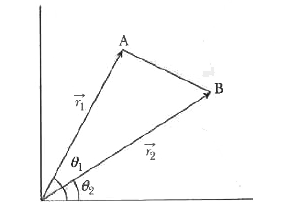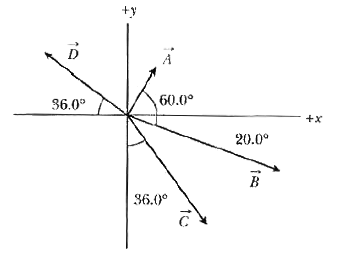Complete Solutions to PRACTICE QUESTIONS of chapter VECTORS of Class 12 book with complete answers and questions
| Class 12 | PHYSICS |
| Chapter | VECTORS |
| RESNICK AND HALLIDAY | PRACTICE QUESTIONS |
| Number Of Questions | 39 |
| Academic Year | 2023-24 |
Which one of the following statements is true concerning scalar quantities ?
View SolutionWhich one of the following quantities is a vector quantity ?
View SolutionWhich one of the following statements concerning vectors and scalars is false ?
View Solution`12` coplanar non collinear forces (all of equal magnitude) maintain a body in equilibrium, then angle between any two adjacent forces is
View SolutionIf vectors `vecA = hati + 2 hatj + 4 hatk and vecB = 5 hati` represent the two sides of a triangle, then the third side of the triangle can have length equal to
View Solutionmark the correct statement .
View SolutionTwo vectors A and B, are added together to form the vector `C = A+B.` The relationship between the magnitudes of these vectors is given by `C _(x) = A cos 30^(@)+B and C _(y)=-A sin 30^(@).` Which statement best describes the orientation of these vectors ?
View SolutionThree vectors A, B, and C add together to yield zero : `A + B + C =0.` The vectors A and C point in opposite direction and their magnitudes are related by the expression: ` A = 2C.` Which one of the following conclusions is correct ?
View SolutionIf vector `vecC` is added to vector `vecD,` the results is a third vector that is perpendicular to `vecD` and has a magnitude equal to `3 vecD.` What is the ratio of the magnitude of `vecC` to that of `vecD` ?
View SolutionGiven that `vecA + 2 vecB= x_(1) hat j 2 vecA - vecB = x _(2) hati + y_(2) hatj,` what is `vecA` ?
View SolutionA vector `vecA` ur is rotated by a small angle `triangletheta` radian `(triangletheta ltl)` to get a new vector `barB` In that case `|vecB-vecA|` is:
View SolutionThe vector `vecA` has components + 5 and + 7 along the x-axes and y-axes, respectively. Along a set of axes rotated 90 degrees counterclockwise relative to the original axes, the vector's components are
View SolutionIn a two-dimensional motion of a particle, the particle moves from point A of position vector `vecr _(1),` to point B of vectors are , respectively, `r _(1) =3 and r _(2) =4` and the angles they make with the x axis are `theta _(1) = 75^(@)and theta_(2) = 15 ^(@),` respectively, then find the magnitude of the displacement vector.

View SolutionEach of two vectors `vecD _(1) and vecD _(2)` lies along a coordinamte axis in the x-y plane. Each vector has its tail at the origin, and the dot product of the two vectors is `vecD_(1), vecD_(2)=- |vecD_(1)|.|vecD_(2)|` Which is possiblility is correct ?
View SolutionTown A lies 20 km north of town B. Town C lies 13 km west of town A.A small plane flies directly from town B to town C. What is the displacement of the plane ?
View SolutionA force `F _(1),` of magnitude `2.0N` and directed due east is exerted on an object. A second force exerted on the object is `F _(2)=2. 0 N,` due north. Wha tis the magnitude and direction of a third force, `F _(3),` which must be exerted on the object so that the resultant force is zero ?
View SolutionA race car will make one lap around a circular track of radius R. When the car has traveled halfway around the track, what is the magnitude of the car's displacement from the starting point ?
View Solutionwhat is the direction of his total displacemetn vector with respect to due east ?
View SolutionConsider the following four force vectors:
`vecF_(1) = 50.0N,` due east, `vecF_(2)= 10.0N,` due east,
`vecF _(3) =40.0N,` due west,` vecF_(4)=30.0N,` due west
Which two vectors add together to give a resultant with smallest magnitude ? In the option below, the two vectors are given followed by a magnitude and direction.
View SolutionTwo bicyclists, starting at the same place, are riding toward the same compground by two different routes. One cyclist rides 1080 m due east and then turns due north and travels norther 1430 m before reaching the campground. The second cyclist starts out by heading due north for 1950 m and then turns and heads directly toward the compground. At the turning point, how far is the second cyclist from the campground ?
View SolutionUse the component method of vector addition to find the components of the resultant of the four displacements show in the figure. The magnitudes of the displacements are : `A = 2. 25 cm, B = 6.35 cm, C =5.47cm and D = 4.19cm.`

View SolutionThree forces are applied to an object, as indicated in the drawing. Force `vecF_(1)` has a magnitude of `21.0` newton `(21.0N)` and is directed `30.0^(@)` to the left of the +y axis. Force `vecF_(2)` has a magnitude of `15.0` N and points along the +x axis. What must be the magnitude and direction (spectified by the angle `theta` in the draeing) of the third force `vecF_(3)` such that the vector sum of the three force is 0 N ?

View SolutionDisplacemtn vector `vecA` points due east and has a magnitude of `2.00km.` Displacement vector `vecB points due north and has a magnitude of `3.75Km.` Displacement vector `vecC points due west and has a magnitude of `2.50km.` Displacement vector `vecD` points due south and has a magnitude of `3.00 km.` Find the magnitude and direction (relative to due west) of the resultant vector `vecA+ vecB+ vecC + vecD.`
View SolutionA jogger travels a route that has two parts. The first is a displacement `vecA` of `2.50 km` due south, and the second involves a displacement `vecB` that points due east, Suppose that `vecA-vecB` had a magnitude of `3.75km.` What then would be the magnitude of `vecB,` and what is the direction of `vecA-vecB` relative to due south ?
View SolutionAt a picnic, there is a contest in which hoses are used to shoot water at a beach ball from three directions. As a result, three forces act on the ball, `vecF_(1), vecF_(2) and vecF_(3)` (see the drawing). The magnitudes of `vecF_(1) and vecF_(2)= 50. 0N and F_(2) = 90. 0N.` Using the graphical technique, determine the angle such that the resultant force acting on the ball is zero.

View SolutionThe x-component of the resultant of several vectors
View SolutionIf ` vecA = 2 hati + hatj + hatk and vecB = hati + hatj + hatk` are two vectores, then the unit vector is
View SolutionTwo vectors, A and B, are added together to form the vector `C = A + B.` The realtionship between the magnitudes of these vectors is given by:
`C _(x) =0`
` C _(y) = A sin 60^(@) + B sin 30^(@)`
`A _(x) and A _(y)` point in the positive x and y directions, respectively.
Which one of the following statements best describes the orientation of vectors A and B ?
View SolutionTwo vectors, A and B, are added together to form the vector `C = A + B.` The realtionship between the magnitudes of these vectors is given by:
`C _(x) =0`
` C _(y) = A sin 60^(@) + B sin 30^(@)`
`A _(x) and A _(y)` point in the positive x and y directions, respectively.
How does the magnitude of A compare with that of B ?
View Solution
Which one of the following statements concerning these vectors is true ?
View Solution
Determine the magnitude of the vector sum, `A + B. `
View Solution
Determine the magnitude of the vector difference , A-B
View SolutionA boat radioed a distress call to a Coast Guard station. At the time of the call, a vector A from the station to the boat had a magnitude of `45.0` km and was directed `15.0^(@)` east of north. A vector from the station to the point where the boat was later found is `B = 30.0km 15.0^(@)` north of east.
What are the components of the vector from the point where the distress call was made to the point where the boat was found? In other words, what are the components of vector `C = B-A ? `
View SolutionA boat radioed a distress call to a Coast Guard station. At the time of the call, a vector A from the station to the boat had a magnitude of `45.0` km and was directed `15.0^(@)` east of north. A vector from the station to the point where the boat was later found is `B = 30.0km 15.0^(@)` north of east.
How far did the boat travel from the point where the distress call was made to the point where the boat was found ? In other words, what is the magnitude of vector C ?
View SolutionIf `vecA = 2 hati + hatj + hatk and vecB = hati + hatj + hatk` are the two vectors, match the following answer the questions by appropriately matching the information given in the three columns of the following table:

The correct alternative for a collinear vector to `vecA` is
View SolutionIf `vecA = 2 hati + hatj + hatk and vecB = hati + hatj + hatk` are the two vectors, match the following answer the questions by appropriately matching the information given in the three columns of the following table:

Which option represents a vector orthogonal to `vecA xx vecB` ?
View SolutionIf `vecA = 2 hati + hatj + hatk and vecB = hati + hatj + hatk` are the two vectors, match the following answer the questions by appropriately matching the information given in the three columns of the following table:

Which vector represents the direction of `vecA xx vecB?`
View SolutionIf `vecB` is added to `vecC = 3. 0 hati + 4. 0 hatj,` the result is a vector in the positive direction of the y axis, with a magnitude equal to that of `vecC.` What is the magnitude of `vecB` ?
View SolutionVector `vecA,` which is directed along an x axis , is to be added to vector `vecB,` which has a magnitude of `7.0m.` The sum is a third vector that is directed along the y axis, with a magnitude that is `3.0` times that of `vecA.` What is that magnitude of `vecA` ?
View Solution
PRACTICE QUESTIONS questions and complete solutions for chapter VECTORS of RESNICK AND HALLIDAY PHYSICS (HINGLISH) of Class 12